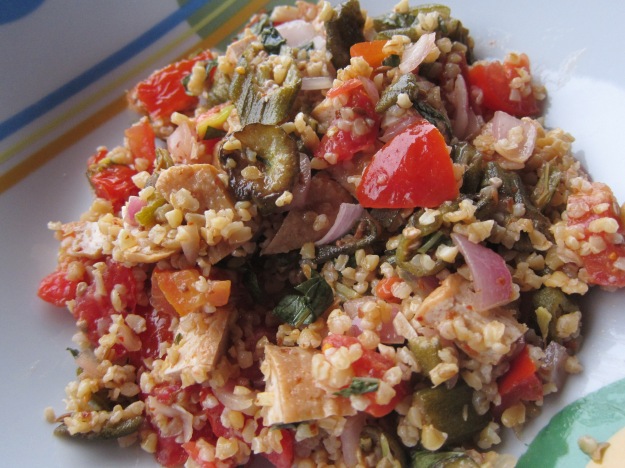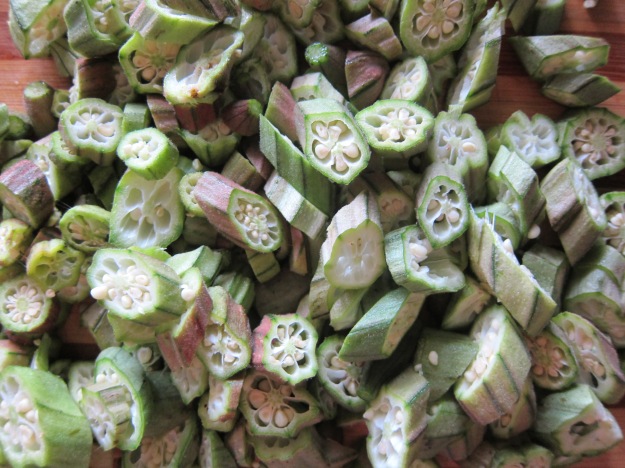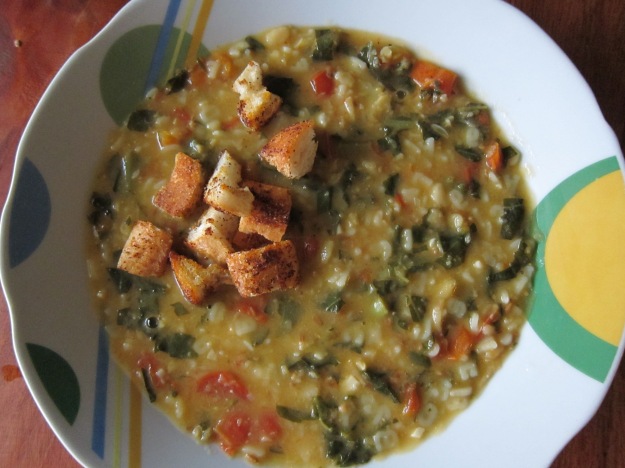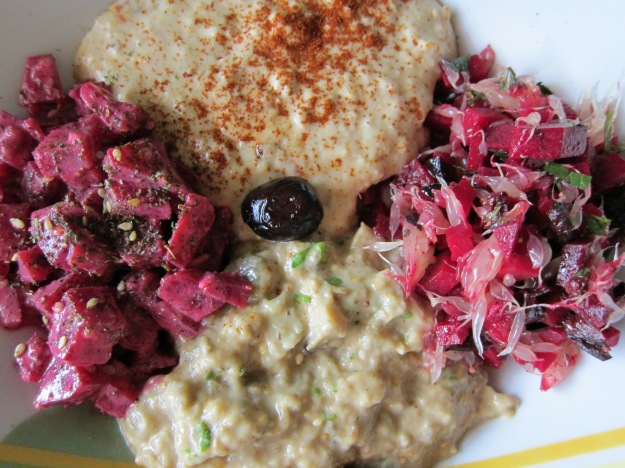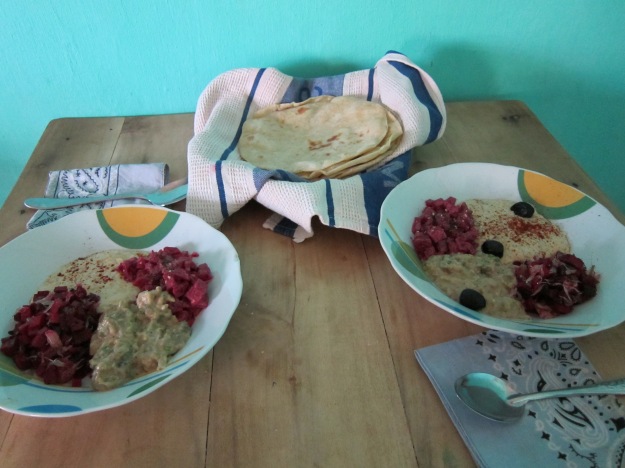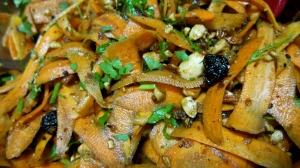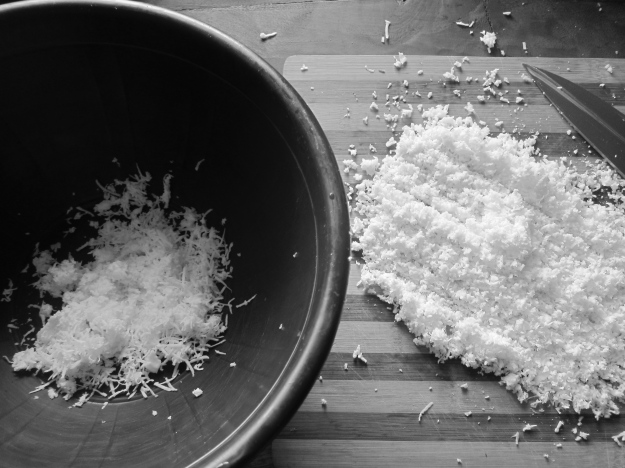Avocados are in season. Depending on the size and quality they are either cheap or really cheap. I put them to good use in a recent sushi bowl dinner. After seasoning rice with salt, sugar and vinegar, I topped each bowl with avocado, quick pickled carrots and cucumbers, nori shake (toasted sesame seeds, nori sheets and salt), pickled ginger and fried tofu. Locally made and freshly fried tofu is sold in our market; I did the pickling and nori shake making in our kitchen. If only I’d thought of this when we were in Cape Verde and fresh tuna was available daily.
Tag Archives: Recipe
Making Gari
I had another manioc adventure a few weeks ago, when I had the opportunity to participate as a cooperative I work with made gari, which is dried, powdered manioc. It’s one of my favorite Beninese foods.
The first step is to have the manioc mashed, which the group paid to have done elsewhere, so I didn’t see that step. We started with large sacks packed full of the smashed manioc, which we broke up into chunks and then sifted through screens.

The woody cores and other remainders on a spare screen. These were fed to the chickens and goats. The sifted manioc is flaky and light.

After sifting the fine powder went over the fire into a big metal pan, where it was toasted until thoroughly dry.

The last step was to put the toasted powder on plastic in the sun. I couldn’t quite figure out what this step accomplished… maybe it was just cooling off?

This is the area where we worked, which is a large courtyard within the cooperative president’s family compound. Most of the day, nobody was willing to be photographed (hence the headless photos), but I was allowed to take this non-close-up shot.
For eating, gari is sprinkled on beans or rice and mixed in with the sauce. Sometimes it is moistened with a little palm oil first, which makes it extra tasty. Yum!
Summer Salad: Bulgur, Okra, Tomato, Onion, Tofu, Basil
Leftover okra (from previous post) makes a great addition to a summer salad. I used bulgur because I was bored of pasta and rice but use whatever grain you want. The veggies, too, are up to you. Whatever is fresh and available will make a great salad. The fried tofu that is available on market days in our town added some grease and chew. Dressed with lemon juice and olive oil, the salad was light enough for the heat of Benin yet hearty enough for a meal.
Recipe: Okra with Cumin, Onions and Lemon Juice from “At Home with Madhur Jaffrey”
Okra has been a longtime nemesis. I can’t get past the slime. So many times the slime dominates okra’s other qualities as well as whatever other dishes its added to. Battered and fried works for me. But what ingredient doesn’t taste great battered and fried? The sub-Saharan climate works well for okra. Even in semi-arid Cape Verde it thrived. Thus, for the past year and a half I’ve tried to overcome my dislike for this veggie. I made pickled okra. Each pickle came out of the jar trailing a string of slime. I added okra to soups and stews. It’s viscosity is a nice thickener but also adds a slimy mouth feel. I slow roasted okra in the oven with a little olive oil. Finished with a squeeze of lemon and a sprinkle of salt, the okra was delicious and slime free. Here in Benin, okra is plentiful but I don’t have an oven for slow roasting vegetables. Back to the drawing board.
I looked to the local preparation in Benin for inspiration. Huge mistake. Pulverized into a thin, slimy sauce that most closely resembles snot in consistency and color, it is eaten with pâte (a bland cornmeal-based porridge that solidifies into the shape of whatever vessel it is stored in). I’ve eaten it three times. My first foray into this local delicacy took place at a lunch stall during my first week of training. I didn’t know what I was ordering. I forced the snot sauce down to be polite. Several weeks later our host mother cooked this sauce. Especially for us, she said. Again, I forced it down. The third time Jen and I were at a funeral banquet. I put a little snot sauce on each bite of food hoping the pâte would cover its yuck factor. It didn’t. I will avoid this sauce for the rest of my time in Benin.
Okra is cheap and one of very few vegetables that is consistently available in our town. For the first three months I passed it each day in the market and never once considered buying any. Then I came across a recipe for okra in At Home with Madhur Jaffrey, a cookbook I recently purchased. I decided to give okra another chance.
I went to the market and asked a vendor for 100 CFA (20 cents) of okra. She put more than a pound of crisp, small, freshly picked okra into a bag. Oops, no way we’ll eat a pound of okra, I thought. I went home, washed and sliced the okra leaving a thick string of okra-snot on my knife and cutting board. I thought about throwing the okra in the garbage. Instead I continued to follow the recipe. The final product was a big surprise. Dark brown and slightly crunchy on the outside, and almost creamy on the inside, the okra had a great consistency. Cumin seeds, salt and a finishing squeeze of lime gave it a bright, flavorful taste. And no sliminess. I’ve made this recipe a half dozen times in the past month and everyone who has tried the finished product says the same thing: I usually don’t like okra but this is really good. I agree.
Okra with Cumin, Onions and Lemon Juice from At Home with Madhur Jaffrey:
1 lb. okra^
1 red onion^ or some shallots
1½ T cumin seeds^^
½ C olive oil^^
1 lemon or lime^
dash cayenne pepper^
s+p
- Slice off top and tip of okra; discard. Then slice horizontally into pieces about ¼ – ½ inch thick.
- Add oil to pan and turn to medium high. When hot, add cumin seeds. Add okra and toss to coat with oil. Let cook for 5 – 8 minutes, stirring every couple of minutes, until okra starts to brown all over.
- Add chopped onion and cook for another 3 – 5 minutes until okra is well browned. It should now be a little less than half its initial volume.
- Season with salt, pepper, cayenne and lemon juice.
^ Ingredient purchased in our town and used by locals on a daily basis.
^^ Ingredient purchased at supermarkets in Porto Novo or Cotonou that cater to wealthier Beninese and foreigners.
^^^ Ingredient sent courtesy of friends and families in care packages.
^^^^ From our garden.
Recipe: Baobab Pancakes
I make baobab pancakes by replacing two tablespoons of white flour with baobab powder. The resulting flavor and chew reminds me of pancakes with yogurt or buttermilk in the batter.
I have been using the same standard pancake recipe for four or five years. I found this recipe on seriouseats.com, I think. As you can see in the recipe below, I no longer measure the milk that I add though it’s probably about two cups. I start with a cup or so and then add more, a tablespoon or two at a time, until I have the consistency I want. The thinner the batter, the thinner the pancake. I prefer my batter to have a consistency of a drinkable yogurt or just slightly thicker than Hershey’s chocolate syrup. At this thickness the batter will cook into pancakes between a quarter and a half inch thick.
Resting the batter helps the batter blend so don’t worry if there are some lumps in your original mixture. It also tends to thicken the batter a bit, thus I start with the batter a little thinner than I want to cook with. After the initial mixing, let the batter rest on the counter for five to ten minutes while you make a cup of coffee, fry up some scrapple or check the score of last night’s game. Then stir the batter and check the consistency. Adjust by adding a little milk or a little flour, a tablespoon or less at a time. If you use a hot non-stick or well-seasoned cast iron pan, no grease is necessary. Though butter makes ‘em better.
Baobab Pancakes: 4 servings
2 2/3 C white flour^
1/3 C baobab powder^
4 t salt^
3t baking powder^
2 T sugar^
2 eggs^
2 T vegetable oil^
2 – 3 C milk ^
- Mix the dry ingredients together.
- Mix the wet ingredients together.
- Combine the wet and dry ingredients. The batter should be the consistency of a drinkable yogurt. Let the batter rest for 5 – 10 minutes.
- Add a little milk if its too dry or a little flour if its too wet.
- Heat a non-stick or cast iron pan until hot but not smoking. Add some butter or oil if you want. Or don’t. Put a ladle full of batter in. When small bubbles have formed and burst all over the pancake, flip it. Cook for another 30 seconds to a minute. Enjoy.
^ Ingredient purchased in our town and used by locals on a daily basis.
^^ Ingredient purchased at supermarkets in Porto Novo or Cotonou that cater to wealthier Beninese and foreigners.
^^^ Ingredient sent courtesy of friends and families in care packages.
Recipe: Beans, Greens, Tomatoes and Pasta Soup with Secret Ingredient
I woke up recently with a craving for a summer barbecue-style bean salad: creamy beans, fresh herbs, crunchy vegetables, tangy vinaigrette with olive oil and lemon. I forgot to start the beans before I left for work but luckily Jen was working at home and could start the beans for me. I asked her to cover a cup of broken fava beans (they’re sold that way in the Lebanese section of my favorite Beninese grocery store) with a couple inches of water and cook them until al dente. Jen put the beans on and then forgot them completely. They cooked to the point of bursting, creating a thick, soupy liquid. No longer ideal for a salad, I changed my plan. Exploded beans make a great base for soup.
Originally I was going to sauté some greens with garlic, cumin and olive oil to serve with the salad. I love the flavor combo and so added the quartet in as a component of the soup. I had some tomatoes that were going to go in the bean salad so they went in, too. At the last minute I added some pasta because I wasn’t sure there’d be enough to eat without it. I seasoned the soup with some vinegar, salt and pepper. It tasted decent but lacked something… Looking at the pantry, the fish sauce called to me. A mainstay of southeast Asian cuisine, fish sauce smells funky. On its own, it takes some getting used to. As a component of a dish it’s a pantry gem, adding layers of flavor and complexity to simple dishes. I added a dash. Then some more. A little goes a long way and the two tablespoons or so that I put in gave the other flavors more punch without dominating with its funkiness. Added at the last minute before eating, the paprika dusted croutons added a bit of crunch.
We let our soup cool until almost room temperature because eating soup in a sauna doesn’t appeal. Just thinking about eating hot soup makes me sweat. This soup, however, would be great on a cold winter night if you are a bit further from the equator than us.
Beans, Greens, Tomatoes and Pasta Soup with Croutons:
Soup:
1 C dried broken fava or other beans^^
3 T olive oil^^
3 T garlic, finely chopped^
2 T cumin seeds^^
4 C loosely packed greens such as spinach, kale, collards, etc., cut into ribbons^
2 C chopped tomatoes^
¼ lb. Israeli couscous, alphabets, stars or other small pasta^^
2 T vinegar (I used cider vinegar) or to taste^
2 T fish sauce or to taste^^
s + p
- Cover beans with two inches of water, bring to a boil and then reduce heat to a simmer. Add a dash of vinegar and a pinch of salt. Cook until the beans fall apart. If they start to dry out, add more water. You want a soupy final product.
- In a separate pot, sauté greens with garlic and cumin seeds in olive oil until wilted; add tomatoes and add a pinch of salt to help release liquid. Cook until tomatoes start to fall apart. Add beans and cooking liquid to greens and tomatoes, add water if too thick. Bring to a boil and then reduce heat to a simmer. Cook for 10 minutes to meld flavors. Better yet, take the pot off the heat, let it cool and put it in the fridge overnight allowing the flavors to fully blend.
- Add enough water so that the soup is thinner than the desired final product as pasta will suck up liquid. Return the soup to a boil and add the pasta. When the pasta is still very al dente, turn off the heat. The pasta will continue to cook so turning it off early prevents it from getting mushy. Season with vinegar, fish sauce, salt and pepper.
Croutons:
2 C leftover bread cut into cubes^
2 T olive oil^^
1 t paprika^^
s + p
- Cut day old bread into cubes. Toast in a dry pan. Drizzle with olive oil until lightly browned. Season with salt, pepper, paprika.
^ Ingredient purchased in our town and used by locals on a daily basis.
^^ Ingredient purchased at supermarkets in Porto Novo or Cotonou that cater to wealthier Beninese and foreigners.
^^^ Ingredient sent courtesy of friends and families in care packages.
^^^^ From our garden.
Recipe: Raw Beet Salad
Clockwise from top: hummus, raw beet salad with basil and orange, baba ganoush, cooked beet salad with yogurt and za’atar. Eaten with fresh pita, all were great except for the cooked beet salad. Next time I’ll double the amount of raw beet salad I make. Here’s a recipe haiku:
To cubed raw beets add
orange segments, olive oil,
basil, salt, pepper.
Recipe: Eggplant with Pasta and Tomato Sauce
On me and Jen’s first date eleven years ago I cooked her eggplant parmesan. I drove down to Berkeley from Truckee to visit. While she was in class I went to Berkeley Bowl (the uncontested greatest supermarket in the US) before cooking a dish I hoped would impress her. After dinner we went for a sunset walk. That first date led to many others. I was fooled into thinking the eggplant parmesan had worked its magic. I learned many months (and dates) later that the eggplant had nothing to do with it. Jen has a strong dislike for eggplant and ate it to spare my feelings. Over the years I occasionally cook eggplant (one of my favorite vegetables) but usually serve it alongside something else for Jen.
A recent craving for eggplant was unfulfilled when I used an amount that I thought Jen would not notice. I cooked rice with eggplant and tomatoes and then tossed it together with a Korean soy, sesame, ginger, garlic sauce. She didn’t notice the eggplant. Nor did I. The craving continued. A recent trip to Porto Novo, Benin’s capital and home to a much better vegetable selection than I find in our town, brought me to the market. I couldn’t resist the eggplant. And, having sealed the deal with wedding vows several years ago, I decided to throw caution to the wind and not hide it under a mountain of other ingredients. The eggplant would be the star.
I dream of eggplant parmesan but it is too much of an undertaking for a weeknight. Cheese is a big challenge without a local store that sells it. No refrigerator compounds the problem. As does lack of an oven. So I decided to make a pasta sauce centered on eggplant but with a little tomato to help pull it together. In starting volume, I had almost three times as much chopped eggplant as tomato. The eggplant cooked down much more than the tomato, but still dominated the flavor. I added the olives and the anchovies at the end for their briny umami. I chopped the olives small enough to enjoy a little in almost every mouthful of pasta. The anchovies melted into the sauce. I love anchovies and can dump a jar onto pasta or bread and call it a meal. But you don’t need to be an anchovy lover to add them into a sauce like this. Their strong flavor gets distributed into the sauce and highlights the other flavors more than anything else.
Anticipating that Jen wouldn’t like the meal, I made some rosemary focaccia to go with the pasta. She started with the focaccia and loved it. I thought she would eat half of her pasta to be polite but the next thing I knew, she was going back for seconds. An eggplant dish for the eggplant wary.
Pasta with Eggplant and Tomato Sauce
¼ C olive oil^^
4 C peeled and diced eggplant^^
6 cloves garlic^
1½C chopped tomatoes^
¼ C oil cured black olives, finely chopped^^
4 anchovy filets^^
pinch crushed red pepper^
s+p
- Dice the eggplant into ¼ – ½ inch cubes. Uniformity doesn’t matter; the cubes will end up melting into the sauce. Finely chop the garlic. Roughly chop the tomatoes. If you want to peel them first, go for it. Or don’t. Or use canned tomatoes.
- Heat the olive oil until very hot but not smoking. Add the eggplant and toss to coat with the oil. It will quickly drink up the oil so act quick. Cook the eggplant for 5 – 8 minutes until its reduced in volume by half. Add the garlic. Cook for an additional 2 minutes. Add the tomatoes and put a lid on the pan. Reduce the heat so the mixture simmers. Let it cook for 10 – 15 minutes, stirring every couple of minutes so it doesn’t stick. During this time the individual tomato and eggplant chunks should break down into a uniform sauce.
- Turn off the heat. Add the olives and the anchovies. Stir. The anchovies will dissolve into the sauce. Season with red pepper, salt and pepper.
- Cook pasta in well salted water and reserve one cup of the cooking water. Toss the drained pasta with the sauce. If its dry, add a bit of the reserved cooking water.
- I finished the pasta with some fresh basil because the basil in our garden is beautiful and plentiful. If you don’t have basil, the dish will still be tasty without it.
^ Ingredient purchased in our town and used by locals on a daily basis.
^^ Ingredient purchased at supermarkets in Porto Novo or Cotonou that cater to wealthier Beninese and foreigners.
^^^ Ingredient sent courtesy of friends and families in care packages.
^^^^ From our garden.
Carrot Salad with Cumin
In Cape Verde, where Jen and I spent our first year of Peace Corps service, I had one cookbook: How to Cook Everything. I needed new blood. I wasn’t smart enough yet to purchase other e-cookbooks. Instead, I had the brilliant idea to buy a cookbook and have it shipped to me. Knowing I only had one chance, I went big and chose the The Essential New York Times Cookbook by Amanda Hesser. Resembling an unabridged OED, my selection cost more to mail to Cape Verde than it did to buy. But Jen’s mom very generously shipped it without–as would have been justified–calling me a moron. When Peace Corps Cape Verde closed and we found out we were being sent to Benin, I hid the cookbook/tome in a bag we sent back to the US with friends who’d visited Cape Verde. Along with Jen’s rock collection. Somehow the bag made the weight limit.
Fortunately, I made good use of the cookbook by studying it daily and cooking from it almost as often. One of the winners from this cookbook was a carrot salad with cumin. Carrots and cumin. It doesn’t roll off the tongue like peanut butter and jelly (nor is there a great Family Guy segment about the pairing) but it is a wonderful combo. This recipe from the Essential NY Times Cookbook sold me on the match.
The idea for the cookbook is straightforward: a sampling of recipes printed in the Times over the past 150 years. Appetizers, vegetables, grains and each other section begins with a timeline showing how ingredients, tastes and presentation styles changed decade by decade. Recipes from each decade follow the timeline. It’s a fun view into America’s culinary history. The short historical notes and stories about each recipe make the book extremely readable. I write love poems to the cookbook in my spare time.
The carrot salad recipe was such a hit that I started to improvise with it from the second time I made it – using various herbs, dried fruit and nuts. It has become one of my go-to side dishes. I’ve made this salad close to a dozen times, first for me and Jen and then for various groups of friends. It’s been a winner with everyone who’s tried it. And it’s just as good the next day so make extra and enjoy.
Carrot Salad with Cumin, Sour Cherries, Almonds and Herbs:
6 medium sized carrots^^
½ C dried sour cherries^^^ (or raisins or dried figs or dried prunes)
½ C balsamic vinegar^^
½ C almonds^^^, pine nuts, peanuts or other nut, crushed
¼ C olive oil^^
1½ T ground cumin^^
½ C loosely packed basil, mint or cilantro leaves (or a combination of the three^^^^)
s+p
- Wash the carrots. Peel them. Or don’t. Then, use a vegetable peeler to slice wide, thin ribbons of carrot. Or cut planks as thinly and evenly as possible with a knife.
- Heat balsamic vinegar until it starts to bubble. Pour the vinegar over the dried cherries. Let the cherries steep in the vinegar. They will drink up the vinegar and rehydrate a bit.
- Prepare the almonds: finely chop with a knife or lightly crush with a mallet. Then, toast in dry pan until fragrant. Add olive oil, cumin and pinch of salt. Toss to evenly coat almonds and continue cooking for a minute. Turn off heat and let the almonds cool.
- When cool, scrape the almond mixture into the carrots; use a spatula to get all of the olive oil from the bottom of the pan onto the carrots. Add the cherries and any extra vinegar from the soaking. Toss and taste. Adjust seasoning. Add extra cumin, vinegar, olive oil, salt, pepper to desired taste.
- Chop herbs and toss with salad just before serving.
^ Ingredient purchased in our town and used by locals on a daily basis.
^^ Ingredient purchased at supermarkets in Porto Novo or Cotonou that cater to wealthier Beninese and foreigners.
^^^ Ingredient sent courtesy of friends and families in care packages.
^^^^ From our garden.
Coconut Chutney Haiku
Grate coconut, chop
onion. Add paprika, salt,
cayenne, vinegar.
*Confession: I appropriated the idea for a recipe haiku from Lucky Peach. More on my love for Lucky Peach here.


